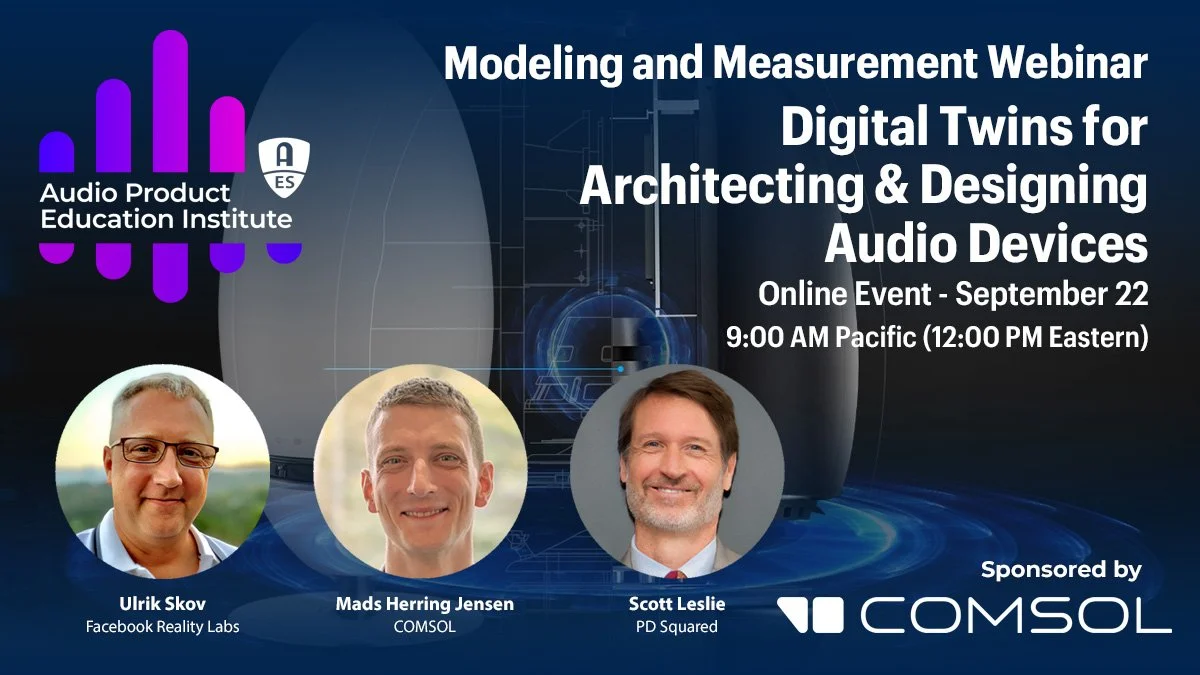"Digital Twins for Architecting & Designing Audio Devices - Part 1”
"Digital Twins for Architecting & Designing Audio Devices - Part 1”
September 22, 2021 | 12-2pm Eastern Standard Time
The AES Audio Product Education Institute (APEI), now known as the Audio Product Development Alliance (APDA), presents a new webinar series on the practice and benefits of simulation-driven audio architecture design by use of Digital Twins. In a new series of Modeling and Measurement online events, experts from COMSOL, Shively Acoustics, and Facebook, will discuss the role of Digital Twins and how advanced experimental transducer identification can be used to influence fundamental design considerations, even before the first prototype is built to proof a concept.
In audio product development, computer modeling and simulations are often used to troubleshoot and optimize acoustic performance once fundamental design assumptions have been defined. And yet, the largest gains in audio performance are consolidated in the very early architectural design phase, where the form factor, transducer choice, and placement dictates the overall acoustic product performance. What if “high fidelity” Digital Twins and advanced experimental transducer identification was used to influence the form factor, transducer type and tuning decisions even before the first prototype is built to proof a concept?
This webinar series focuses on how experimental transducer and virtual simulation-driven audio architecture explorations can work alongside, impacting the very early product development cross-functional discussions with PM (Program Management), PD (Product Development) and ID (Industrial Design). With expert contributions from Shively Acoustics and Facebook, the webinar series will share methods and experiences on how to meet PMs desired audio user experience, PDs manufacturing strategy/story, and IDs aesthetics and function.
The webinar series will provide an overview of how measurement and Digital Twins can front-load and address optimal acoustic insights to influence audio product architecture in the critical first 2-4 months of a project. The first webinar will offer an introduction to fundamental aspects, and will expand over additional events, featuring presentations and case studies. The presentations will also explore the corresponding strategies to inform and qualify the first physical prototype made for proof of concept, and validate a commitment to investment on a product idea.
Next Sessions
October 27 – Modeling and Measurement
Digital Twins for Architecting & Designing Audio Devices – Session 2
November 17 – Modeling and Measurement
Digital Twins for Architecting & Designing Audio Devices – Session 3
From Troubleshooter to Virtual Acoustic Architect/Designer
Together, we will look at questions such as how and why very early experimental and virtual acoustic insight coexist, and how they can change or modify an audio product’s form factor, cost, transducer type/placement, and performance, considering both acoustics and reliability. We will also explore how this can help determine cross-functional collaborative decision-making. As an example, where the acoustic transducer team works closely with the audio tuning/DSP team to enable at times highly compromising design constraints.
The webinar series will discuss organizational methods and resources that are available for learning the how-to’s, anticipating the challenges to establish this front-loaded architectural process in mature or new companies. How to adjust practices. How to seek senior management support. What it takes to change/enhance a well-known development process where cross-functional partners are encountering a data driven, early “Digital Twin push back”. How to handle opportunities from an audio team eager to establish dialog and arrive at the best architectural starting point for audio design and optimization. In other words, how to change an organizations behavior from a typical reactive, problem-solving mode, to a simulation-driven front-loading architecture, benefiting from very early insights from Digital Twins. How to establish high fidelity digital twins of transducers and systems. And how simulation engineers can leverage cross-functional discovery/incubation stages to expand their sphere of influence – from troubleshooters and optimizers to become architectural design leads.
More information about this online event and future APEI webinars can be found on their website here.
View this online webinar right now on demand here.
Stay tuned for the next session on Digital Twins, as Roger will be a featured contributor!
The mission of the APEI Automotive Pillar is to explore and explain the practical approach and development of all the products that are conceived, planned, designed, and implemented in automotive car audio. They plan to hold an online session for Automotive Audio every month, so stay tuned for our upcoming sessions in 2021.
We look forward to seeing you all there virtually in the chat!



